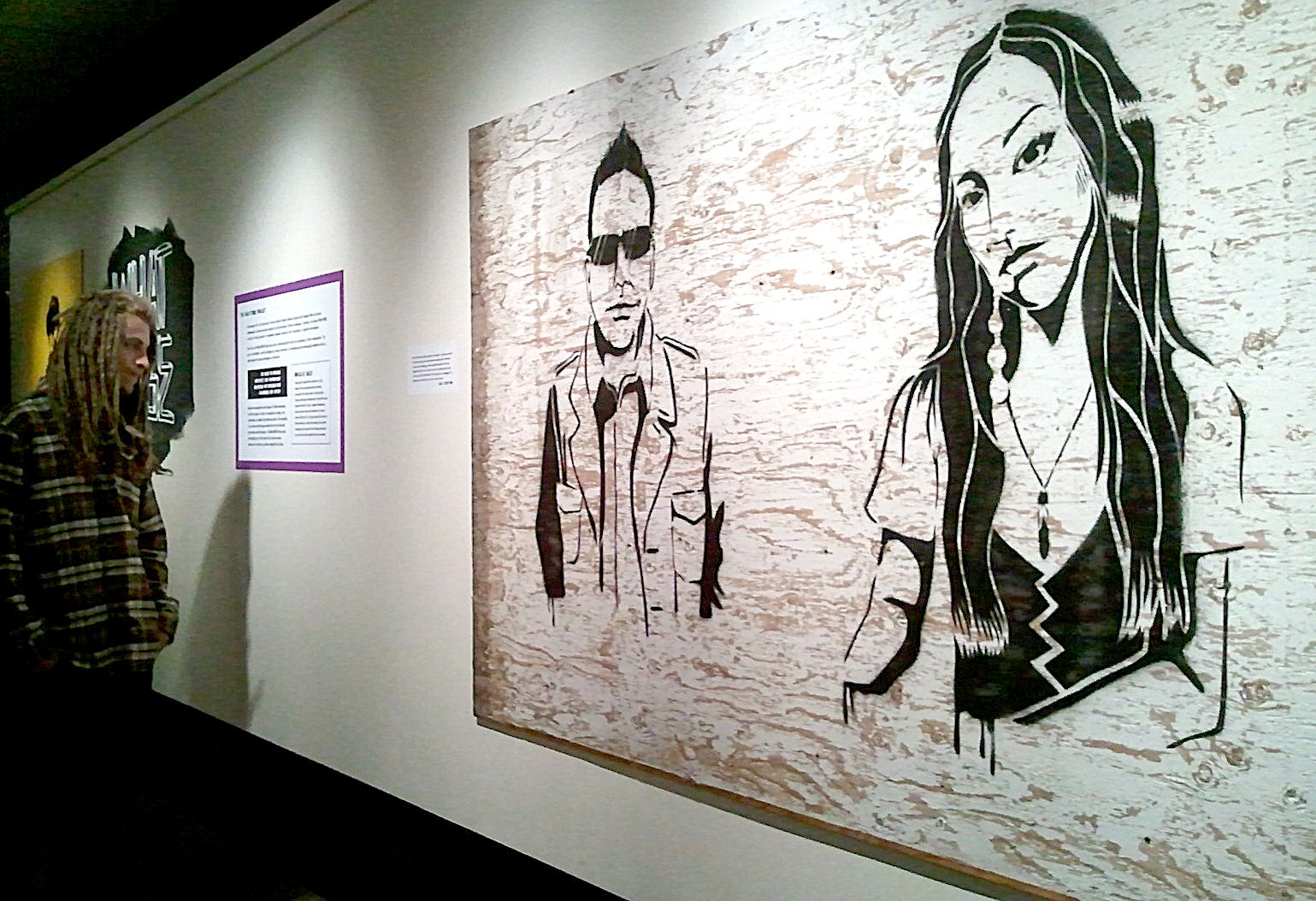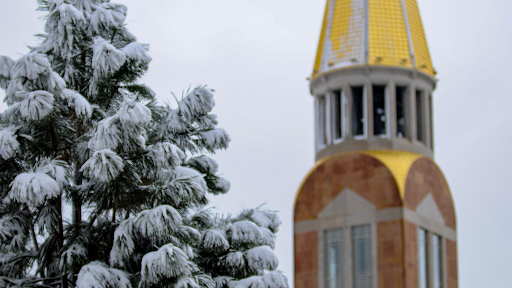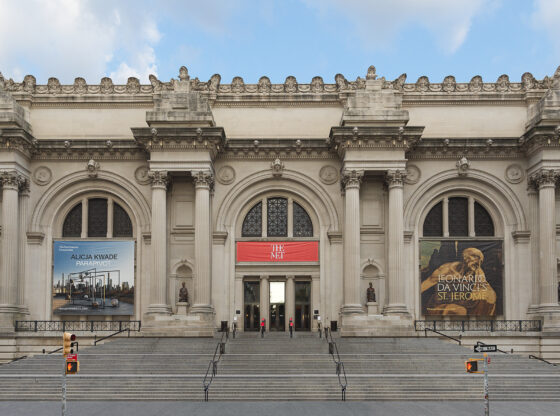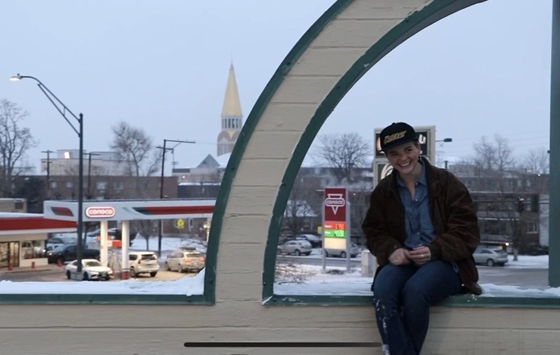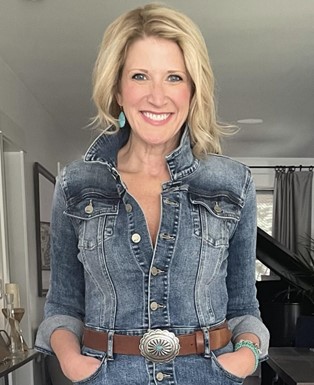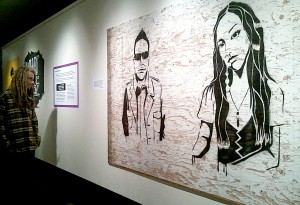
The Native Student Alliance teamed up with artist Douglas Miles, founder of Apache Skateboards, to present the WhatTRIBE exhibit in Sturm Hall’s Museum of Anthropology, holding the opening reception last Thursday from 4-7 p.m. This multimedia exhibit featured stencil portraits of several DU students along with poetry, music and a slideshow. The predominant medium consisted of spray paint, cardboard and reclaimed wood, all found in the Denver community.
“I wanted to take something from the community,” said Miles. “I wanted to work with people and material from the community; I found the wood and the subjects here so the exhibit has even more meaning.”
A San Carlos Apache-Akimel O’odham painter and printmaker from Arizona, Douglas Miles incorporates Native American culture into his urban art-styled pieces, like those in his Apache Skateboards products. Miles has worked with IPath, Volcom, Element Skateboards to create a stamp of Native life.
At the far end of the small gallery, an ongoing slideshow projected black-and-white photographs of various students onto the wall. These students held up a paper with the graffiti-style words “What Tribe?” Their responses to the question ranged from ethnicity, occupation and interest: Student/ New Mexican; Theatre; Anthro nerd/ Brony/ Texan.
“We told people about the project and asked if they wanted to support it,” said Amanda Williams, a senior from Arizona majoring in Psychology and co-chair of NSA. “So they sent in pictures. It was a very collaborative project.”
Indeed, the WhatTRIBE exhibit was a collaboration between many factions, including the Anthropology Department and the Center for Multicultural Excellence which provided some of the funding.
“The NSA came to us and had this idea and we said sure,” said Christina Kreps, a faculty in the Department of Anthropology and Director of the Museum of Anthropology. “This gallery is a student space so we’re happy when people come to us with ideas. This is exactly the kind of exhibit we like to support.”
Miles expressed a perspective that broadened the definition of the term “tribe” by including non-ethnic criteria such as interests, occupation, religion, age, habits and fandom. As such, a Theatre club could consider themselves a tribe connected by the members’ fundamental love for the performing arts. The idea runs similar to the modern American concept of ‘family’ which often includes distant blood-relatives or even friends. Miles’ expansion of the conventional definition of tribe allowed for more people to connect through a variety of shared traits, ultimately creating a stronger sense of unity throughout the DU campus.
“I’m not here to inspire some new kind of Pan-American movement,” said Miles, who wished to break negative Native American stereotypes with this exhibit, while simultaneously encouraging the DU community to reflect on their own tribal backgrounds. “I’m talking about reflecting on your own background and being proud of it. We all have our tribal backgrounds; we all come from somewhere.”
The WhatTRIBE exhibit used its Native American emphasis as a bridge, reaching out to other cultures and ‘tribes’, and asking people to share their backgrounds in a unified celebration of community.
“We all have our own history and we want to share it with everyone,” said Williams. “We don’t want to blame anyone. Instead of picking at each other, we wanted create an exhibit with an interactive feature that would have the DU community involved.”
Miles found the inspiration for the student and faculty portraits when he was invited to the DU campus by NSA last year and snapped photos of students, whom he proceeded to draw in stencil paint upon bright red, green and white canvases.
In the exhibit, the portraits were accompanied by poetic personal statements written by the subjects themselves wherein they explored the complexities of their personal and tribal identities, and posed related questions to the viewer.
Felipe Diaz, a fifth year from Greeley majoring in Journalism and Political Science, commented on the appropriateness of the portraits’ chosen medium.
“They’re stencils, but it correlates with the indigenous aspect as being below mainstream,” said Diaz. “I like the indigenous quality and the underground vibe.”
But Miles expressly stated that he wished to do so using a positive sentiment.
“The goal is to facilitate a creative dialogue by raising awareness of stereotyping and encouraging students to take a stand against the many stereotypes of minorities,” said Miles. “We want to provoke creativity. Not controversy. Discussion. Not discrimination. Awareness. Not apathy.”
The WhatTRIBE exhibit will run until May 3 in the Museum of Anthropology located in Sturm 102. Museum hours are 9 a.m. through 4 p.m. Monday through Friday. Afterward, the DU community can look forward to the NSA’s annual Powwow event which will be held May 19, on DU’s Driscoll Green from 1 p.m. until sundown.

